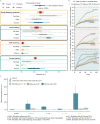Effects of public-health measures for zeroing out different SARS-CoV-2 variants
- PMID: 37644012
- PMCID: PMC10465600
- DOI: 10.1038/s41467-023-40940-4
Effects of public-health measures for zeroing out different SARS-CoV-2 variants
Abstract
Targeted public health interventions for an emerging epidemic are essential for preventing pandemics. During 2020-2022, China invested significant efforts in strict zero-COVID measures to contain outbreaks of varying scales caused by different SARS-CoV-2 variants. Based on a multi-year empirical dataset containing 131 outbreaks observed in China from April 2020 to May 2022 and simulated scenarios, we ranked the relative intervention effectiveness by their reduction in instantaneous reproduction number. We found that, overall, social distancing measures (38% reduction, 95% prediction interval 31-45%), face masks (30%, 17-42%) and close contact tracing (28%, 24-31%) were most effective. Contact tracing was crucial in containing outbreaks during the initial phases, while social distancing measures became increasingly prominent as the spread persisted. In addition, infections with higher transmissibility and a shorter latent period posed more challenges for these measures. Our findings provide quantitative evidence on the effects of public-health measures for zeroing out emerging contagions in different contexts.
© 2023. Springer Nature Limited.
Conflict of interest statement
The authors declare no competing interests.
Figures





Similar articles
-
Flexible, Freely Available Stochastic Individual Contact Model for Exploring COVID-19 Intervention and Control Strategies: Development and Simulation.JMIR Public Health Surveill. 2020 Sep 18;6(3):e18965. doi: 10.2196/18965. JMIR Public Health Surveill. 2020. PMID: 32568729 Free PMC article.
-
Mathematical assessment of the impact of non-pharmaceutical interventions on curtailing the 2019 novel Coronavirus.Math Biosci. 2020 Jul;325:108364. doi: 10.1016/j.mbs.2020.108364. Epub 2020 May 1. Math Biosci. 2020. PMID: 32360770 Free PMC article.
-
Impact of self-imposed prevention measures and short-term government-imposed social distancing on mitigating and delaying a COVID-19 epidemic: A modelling study.PLoS Med. 2020 Jul 21;17(7):e1003166. doi: 10.1371/journal.pmed.1003166. eCollection 2020 Jul. PLoS Med. 2020. PMID: 32692736 Free PMC article.
-
Quarantine alone or in combination with other public health measures to control COVID-19: a rapid review.Cochrane Database Syst Rev. 2020 Sep 15;9(9):CD013574. doi: 10.1002/14651858.CD013574.pub2. Cochrane Database Syst Rev. 2020. PMID: 33959956 Free PMC article.
-
Physical distancing, face masks, and eye protection to prevent person-to-person transmission of SARS-CoV-2 and COVID-19: a systematic review and meta-analysis.Lancet. 2020 Jun 27;395(10242):1973-1987. doi: 10.1016/S0140-6736(20)31142-9. Epub 2020 Jun 1. Lancet. 2020. PMID: 32497510 Free PMC article.
Cited by
-
Assessing the effectiveness of test-trace-isolate interventions using a multi-layered temporal network.Infect Dis Model. 2025 Mar 14;10(3):775-786. doi: 10.1016/j.idm.2025.03.005. eCollection 2025 Sep. Infect Dis Model. 2025. PMID: 40201709 Free PMC article.
-
Time series analysis of the impact of air pollutants on influenza-like illness in Changchun, China.BMC Public Health. 2025 Apr 18;25(1):1456. doi: 10.1186/s12889-025-22110-x. BMC Public Health. 2025. PMID: 40251555 Free PMC article.
-
Telomere length and COVID-19 disease severity: insights from hospitalized patients.Front Aging. 2025 Jun 10;6:1577788. doi: 10.3389/fragi.2025.1577788. eCollection 2025. Front Aging. 2025. PMID: 40556866 Free PMC article.
-
Impact of prior SARS-CoV-2 infection on college students' hesitancy to receive additional COVID-19 vaccine booster doses: A study from Taizhou, China.Prev Med Rep. 2024 Mar 29;41:102709. doi: 10.1016/j.pmedr.2024.102709. eCollection 2024 May. Prev Med Rep. 2024. PMID: 38576514 Free PMC article.
-
Inactivated vaccine effectiveness against symptomatic COVID-19 in Fujian, China during the Omicron BA.2 outbreak.Front Public Health. 2023 Dec 14;11:1269194. doi: 10.3389/fpubh.2023.1269194. eCollection 2023. Front Public Health. 2023. PMID: 38162626 Free PMC article.
References
Publication types
MeSH terms
Supplementary concepts
Grants and funding
LinkOut - more resources
Full Text Sources
Medical
Miscellaneous

